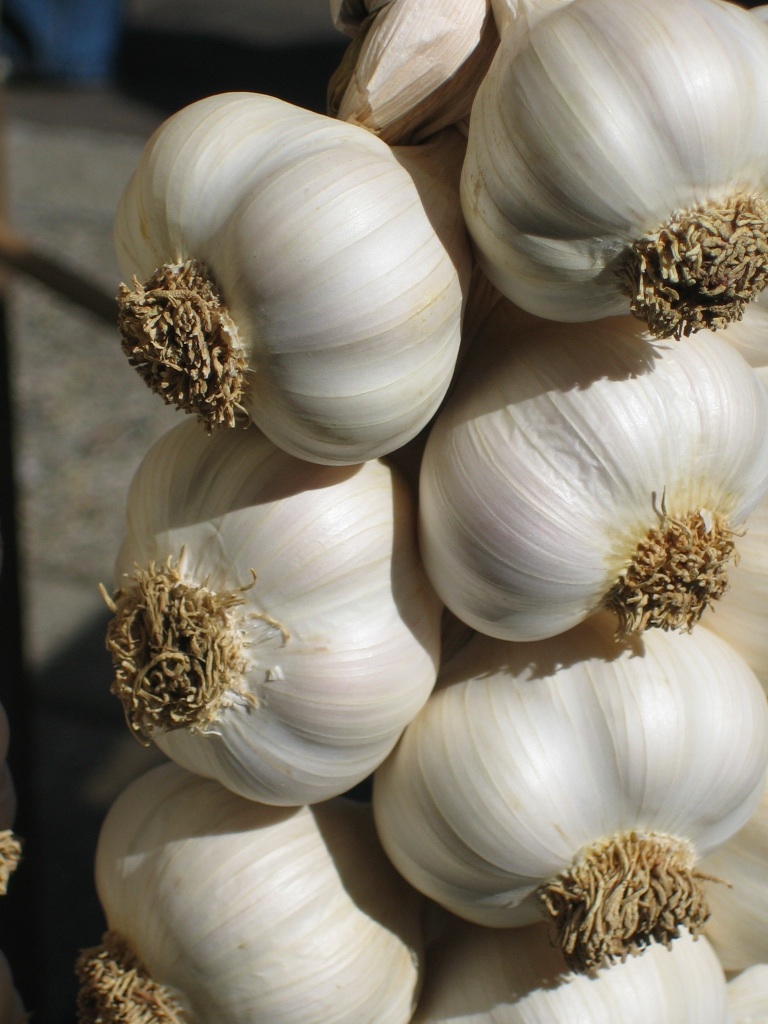|
16 October 2025
|
|
|
മലയാളം
|
|
|
|
|
|
Agriculture > Vegetables
> Garlic
|
|
|
|
|
|
About the crop
|
|

Garlic is an important cool season bulb crop that is widely used around the world
for its pungent flavour, as a spice or condiment. The head of garlic comprising
numerous discrete cloves is the edible part. Garlic is suitable for growing
as a winter crop in the high ranges of Kerala.
|
|
Climate & Soil
|
|
|
|
Garlic requires cool and moist period during vegetative growth and a dry spell during
maturity of the bulbs. Fertile, well drained loamy soils are ideal for garlic cultivation.
Heavy clay soils may result in deformed bulbs. In high ranges of Kerala, garlic
can be planted during October-November.
|
|
Propagation & Planting
|
|
|
|
Varieties: Ooty-1, G 50
Planting
Cloves or bulbils are used for propagation. For planting one hectare, 500 kg of
cloves is required. The cloves for planting should be stored for 2-3 months after
harvest and cloves weighing 4 g are ideal for planting. The cloves should be soaked
in water followed by dipping for 15 minutes in a solution containing 1 ml of dimecron
and 1 g of carbendazim dissolved in 1 litre of water for 15 minutes. After drying
in shade, cloves can be used for planting.
Dig the land thoroughly and prepare beds of 15 cm height at a width of 1 m and of
convenient length. The cloves should be dibbled at a spacing of 15 x 8 cm. Germination
will start on the fifth day and it will be completed within 10-15 days.
Top
|
|
Intercultural Operations
|
|
|
|
Manuring
Apply N:P2O5: K2O @ 60:120:120 kg/ha 20 days after
transplanting (DAP). Topdressing of N should be done @ 60 kg/ha, 45 DAP.
Irrigation
In the initial stages of crop growth frequent irrigations are given to encourage
vegetative growth i.e., once in a week. Irrigation intervals are increased with
crop maturity and finally irrigation is withheld.
Weed control
Weeding and hoeing are done as and when necessary. Being a closely planted crop,
inter cultural operation has to be done with utmost care avoiding crop injury.
Earthing up
Earthing up should be done 60 DAP
Top
|
|
Plant Protection
|
|
|
Pests
Thrips (Thrips tabaci)
Nymphs and adult thrips lacerate the epidermis of leaves and suck the exuding cell
sap. The affected leaves show silvery blotches, which later turn into brownish colour,
and the plants ultimately wilt and dry away.
Maggot (Hylemia antiqua)
The larva enters into soil and damage disc portion of bulb. Infested plants turn
yellowish brown and finally dry up. The affected bulbs rot in storage.
Control: Regular crop rotation should be followed and thimet should be applied in
the soil before transplanting.
Cutworms (Agrotis ipsilon)
Young larvae cut the seedlings at ground level during night and hide during day.
The tender plants are found damped at ground level during the night.
Control: Chlorpyriphos (5ml/litre) gives good control of this pest.
Diseases
Blast, damping off, basal rot, downy mildew, smut, bacterial brown rot, anthracnose,
white rot, and neck rot are some of the diseases found serious in garlic crop under
north Indian conditions. To control blast, spray mancozeb (2 g/litre). Following
proper sanitary and phytosanitary measures will take care of the disease and normally
no pesticide spray is needed.
Top
|
|
Harvesting
|
|
|
|
The garlic crop is ready for harvesting when tops turn yellowish or brownish and
show signs of drying up and bend over. Depending on season and soil, harvesting
can be done 120-130 DAP. Yield may vary from 5-10 t/ha. The bulbs are cured in field
for about a week after harvesting. In order to avoid damage from sun, the bulbs
are covered along with the tops of each other. After this the bulbs are cured for
another 7-8 days in shade either with tops or after cutting tops by leaving 2.5
cm. Curing in shade may be on a floor having ventilation from bottom or a wire racks.
Grading is done according to size, colour and shape.
Top
|
|
|
|
|
|